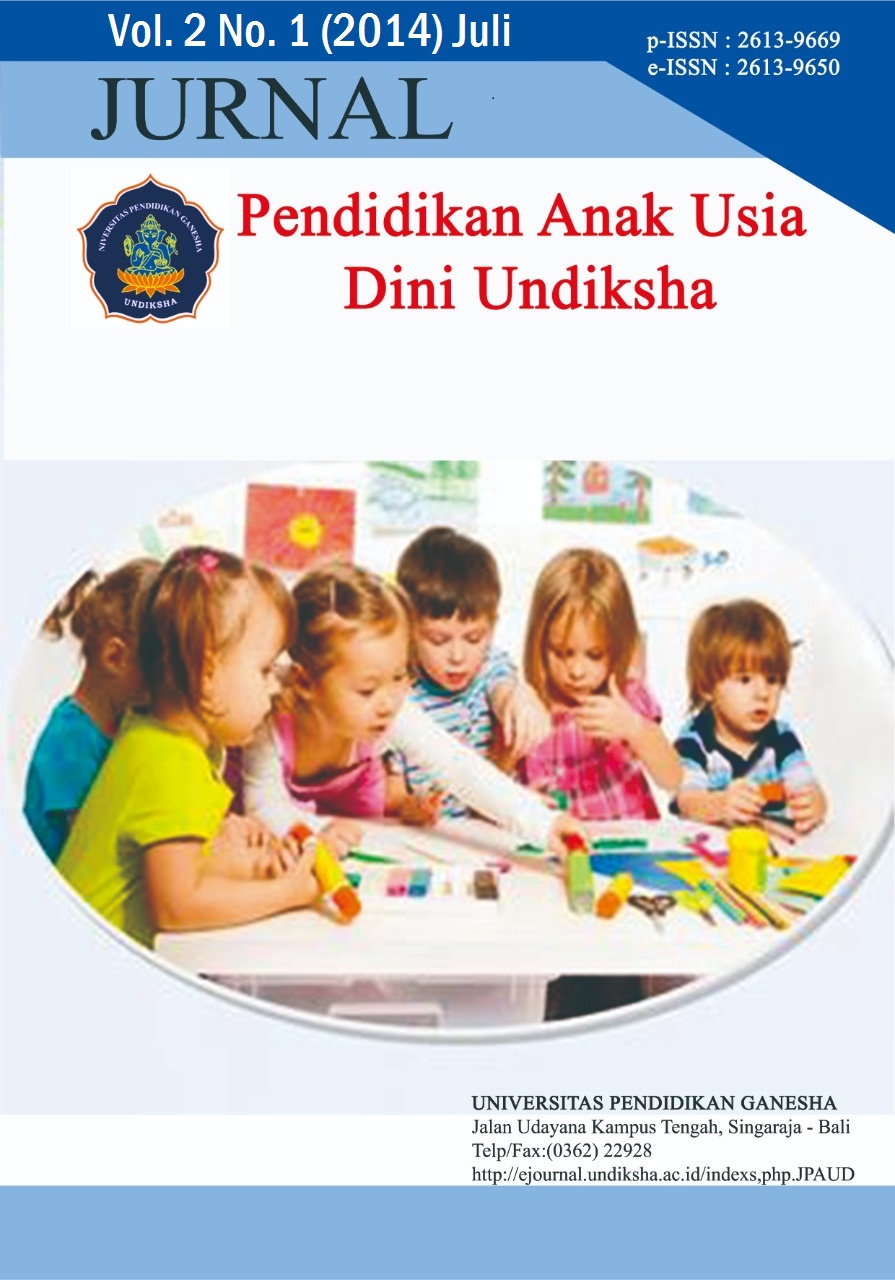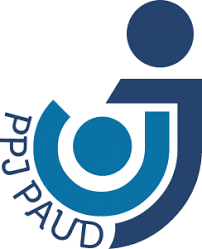PENERAPAN METODE BERCAKAP-CAKAP BERBANTUAN MEDIA KOTAK ALPHABET UNTUK MENINGKATKAN KEMAMPUAN BERBAHASA LISAN ANAK KELOMPOK B SEMESTER II TK LAKSANA KUMARA DENPASAR TAHUN PELAJARAN 2013/2014
DOI:
https://doi.org/10.23887/paud.v2i1.3169Abstrak
Penelitian ini bertujuan untuk meningkatkan kemampuan berbahasa lisan anak melalui penerapan metode bercakap-cakap berbantuan media kotak alphabet anak kelompok B semester II TK Laksana Kumara Denpasar tahun pelajaran 2013/2014. Penelitian ini merupakan Penelitian Tindakan Kelas (PTK) yang dilaksanakan dalam dua siklus. Subjek dalam penelitian ini adalah 27 orang anak, 14 anak perempuan dan 13 anak laki-laki TK kelompok B semester II tahun pelajaran 2013/2014. Data kemampuan berbahasa lisan dikumpulkan menggunakan metode non tes (wawancara/percakapan) dengan instrumen lembar wawancara dan observasi. Data yang diperoleh dianalisis menggunakan teknik analisis statistik deskriptif kuantitatif. Analisis data dilakukan dengan membandingkan hasil dari siklus I dan siklus II. Hasil pada siklus I diketahui pencapaian kemampuan berbahasa lisan sebesar 39,07% dengan kategori sangat rendah. Sedangkan pada siklus II pencapaian kemampuan berbahasa lisan sebesar 96,22% dengan kategori sangat tinggi. Dengan demikian dapat disimpulkan bahwa dengan menerapkan metode bercakap-cakap dan media kotak alphabet dapat meningkatkan kemampuan berbahasa lisan anak kelompok B semester II TK Laksana Kumara Denpasar sebesar 57,15%.Kata Kunci : metode bercakap-cakap, media kotak alphabet, kemampuan berbahasa lisan
This research was aimed to improve children’s oral speaking skill through the implementation of conversation method assisted with alphabet box media for children on B group upon II semester TK Laksana Kumara Denpasar on the academic year 2013/2014. This research is Action Class Research which is conducted in 2 cycle. The subject of this research is 27 children, 14 are female and the rest are male in a group B II semester academic year 2013/2014. Oral speaking skill data was collected by using non-test method (interview/conversation) through interview and observatin sheet as an instrument. The data obtained was analyzed by using analysis statistics descriptive quantitative technique. The data analysis conducted by comparing the result of cycle I and II. The result of cycle I stated that the oral speaking skill achievement was 39.07 % which is categorize as low achievement. Furthermore, on the cycle II, the oral speaking skill achievement was 96.22 % which is categorize as very high achievement. Thereby, it can be concluded that with the implementation of conversation method and alphabet box media is able to improve children’s oeal speaking skill group B children II semester TK Laksana Kumara Denpasar reaching 57.15%.
keyword : conversation method, alphabet box media, oral speaking skill
Diterbitkan
2014-07-01
Cara Mengutip
., P. L. A. D., ., D. I. W. S. M., & ., D. M. P. M. (2014). PENERAPAN METODE BERCAKAP-CAKAP BERBANTUAN MEDIA KOTAK ALPHABET UNTUK MENINGKATKAN KEMAMPUAN BERBAHASA LISAN ANAK KELOMPOK B SEMESTER II TK LAKSANA KUMARA DENPASAR TAHUN PELAJARAN 2013/2014 . Jurnal Pendidikan Anak Usia Dini Undiksha, 2(1). https://doi.org/10.23887/paud.v2i1.3169
Terbitan
Bagian
Articles
Lisensi
Authors who publish with the Jurnal Pendidikan Anak Usia Dini Undiksha agree to the following terms:
- Authors retain copyright and grant the journal the right of first publication with the work simultaneously licensed under a Creative Commons Attribution License (CC BY-SA 4.0) that allows others to share the work with an acknowledgment of the work's authorship and initial publication in this journal.
- Authors are able to enter into separate, additional contractual arrangements for the non-exclusive distribution of the journal's published version of the work (e.g., post it to an institutional repository or publish it in a book), with an acknowledgment of its initial publication in this journal.
- Authors are permitted and encouraged to post their work online (e.g., in institutional repositories or on their website) prior to and during the submission process, as it can lead to productive exchanges, as well as earlier and greater citation of published work. (See The Effect of Open Access)











